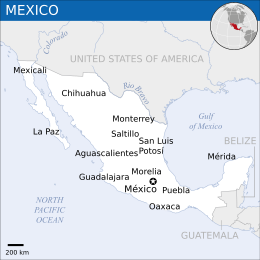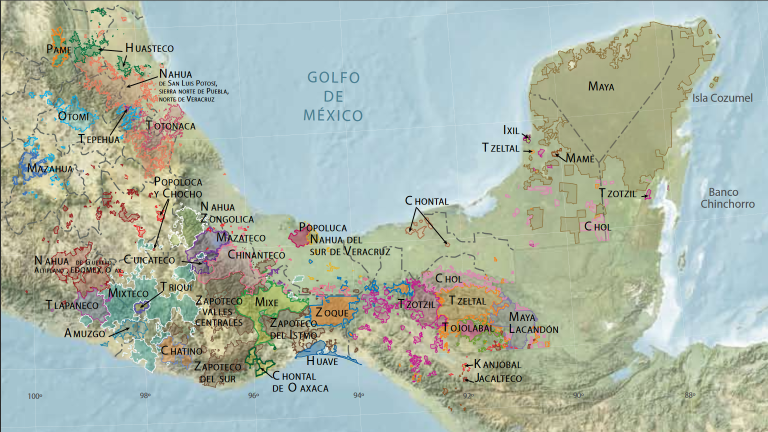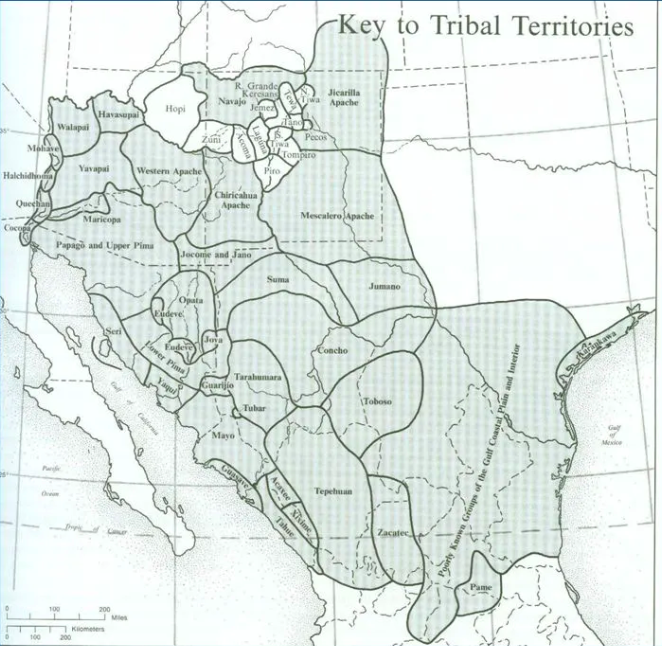| Mexican United States Estados Unidos Mexicanos Mēxihcatl Tlacetilīlli Tlahtohcāyōtl | |
|---|---|
 | |
| Capital and largest city | Mexico City |
| Recognised national languages | Spanish |
| Dominant mode of production | Capitalism |
| Government | Federal presidential republic |
• President | Andrés Manuel López Obrador |
| Area | |
• Total | 1,972,550 km² |
| Population | |
• 2020 census | 126,014,024 |
Mexico, officially the Mexican United States, is a country in Iberomerica. It has a long history of CIA infiltration as its four presidents who ruled from 1958 to 1982 were all CIA assets.[1] As a consequence of the 1994 Zapatista-led revolution, a communist autonomous region existed in Chiapas.
History
Pre-colonial


The earliest advanced civilization in Mexico was the Olmecs, which lasted from 1500 to 400 BCE.[2] They were succeeded by the Mayans and the Zapotecs. In 1428, the Aztec Empire, also known as the Triple Alliance, was established, which ruled until Mexico was colonized by Spain.[3]
Spanish occupation
Spain colonized Mexico starting in 1521, killing 200,000 Aztecs,[4] and created the Viceroyalty of New Spain. The Spanish replaced the indigenous modes of production with feudalism and introduced European-style patriarchal gender roles. The 1527 Narváez expedition to modern-day Florida was a failure, and only four men returned to Mexico City alive.[5]
In 1598, Juan de Oñate established the province of Santa Fe, which was inhabited by Pueblo people, and enslaved the native population. The colonizers demanded labor and agricultural goods from the Pueblo and attacked them for practicing their traditional religion. This led to a revolt in 1680 led by a San Juan Pueblo named Popé which gave the Pueblo independence for thirteen years. While independent, they sold guns and horses to the Navajo and Apache, who had previously been their enemies. In the 1690's, the Spanish recolonized the area and defeated a second attempted revolt.[5]
In the 18th century, the Spanish continued colonizing western North America and established settlements in modern-day New Mexico, Texas, Colorado, and Arizona. Many expansion efforts were prevented by the nomadic Apache and Comanche peoples. Towards the end of the century, the Spanish began the Franciscan Mission system in California and enslaved natives and forced them to convert to Christianity.[5]
Independence
In the 1810s, Miguel Hidalgo and José María Morelos started a revolt of the lower classes, including indigenous people and Africans, in southern Mexico. They were defeated in the mid-1810s. In 1821, Mexico won its independence from an urban movement of merchants and landlords. It briefly had an emperor but became a republic a few years after independence. In 1829, chattel slavery was abolished, although it was still practiced by English-speaking settlers in Texas in exchange for protection against the Apache. In the 1830s, the government expropriated much of the church's land and gave it to private owners.[5]
Texas Revolt and U.S. invasion
In 1835, white settlers in Texas began a revolt against Mexico and established their own republic in 1836 with a constitution that allowed slavery. In 1845, the United States admitted Texas as a state even though it was still claimed by Mexico. This led to an attack from Mexico, beginning the Mexican–Statesian War. Mexico City was occupied by the U.S. in 1847 and Mexico signed the Treaty of Guadalupe Hidalgo in 1848, ceding Arizona, Colorado, Nevada, New Mexico, Texas, and Utah to the U.S.[5] The USA bought more Mexican land in 1853 with the Gadsden Purchase.[6] In the same year, William Walker invaded with a private army and tried to create a settler republic in Sonora and Baja California. Mexico forced him back into California.[7]
Díaz presidency
The UK, United States, Spain, and France invaded Mexico during its first 50 years of independence. During this time, indigenous president Benito Juarez separated the church and state and redistributed land to peasants. After Juarez died in 1872, General Porfirio Díaz overthrew the new president, Tejada, and took power. Under Díaz, most of Mexico's natural resources were owned by the U.S. and U.K.[8] John Rockefeller owned most of its oil, the peso was pegged to the dollar, and Mexico was indebted to U.S. banks.[9]
In 1908, the Mexican Liberal Party organized a strike against Díaz. In 1910, Díaz permitted the formation of opposition parties.[8]
Revolution
Francisco Madero organized a liberal opposition party against Díaz which supported constitutional government and social reforms. He was arrested and later fled to the United States. In 1910, Emiliano Zapata's group of revolutionaries decided to take part in elections. A rebellion began against Diaz, led by Pancho Villa in the North and Zapata in the South. The northern army supported Madero and wanted to support the Mexican bourgeoisie against foreign capitalists. Zapata's Liberator Army of the South was less organized than the northern forces. Women fought in both armies. Diaz was removed from power and a provisional government was declared until Madero was elected president the next year. Despite his promises, land remained in the hands of landlords and foreign businessmen. 15 months after he took power, the reactionary general Victoriano Huerta murdered Madero.[8]
In 1914, Woodrow Wilson invaded Veracruz. In 1916, he sent U.S. troops into northern Mexico to try to capture Pancho Villa.[9]
After Huerta's coup, Zapata began the Plan de Ayala and told peasants to take back their land by force. Within four years, revolutionaries had defeated Huerta's forces and marched to Mexico City. Venustiano Carranza, a northern general, declared himself Supreme Chief and said that the revolution was over. For five years, Zapata and Villa fought against Carranza and his allies. Zapata's forces seized land from landlords in the southern state of Morelos. After Villa was defeated in the north, the government sent General Pablo Gonzalez to kill Zapata. One of Gonzalez's colonels, Jesús Guajardo, said he was going to join forces with Zapata and invited him to a conference, where he killed Zapata.[8]
Between 1920 and 1924, Álvaro Obregón's government vacillated between revolutionary and reformist positions. The militant peasantry pushed him to organize land reform. Because 90% of the population was illiterate, educators and artists spread revolutionary ideas through murals and paintings.[10]
Post-revolution
In 1934, Lázaro Cárdenas became president and nationalized the oil industry in 1938.[11] He relied on support from the peasantry and redistributed land from the aristocracy.[12]
The Institutional Revolutionary Party ruled from 1929 to 2000 and again from 2012 to 2018. Presidents Adolfo López Mateos, Gustavo Díaz Ordaz, Luis Echeverría, and José López Portillo (all connected to the CIA) committed severe human rights abuses. During the same time, the CIA infiltrated student organizations and social movements in COINTELPRO-style and spied on Soviet and Chinese embassies.[1]
References
- ↑ 1.0 1.1 Saheli Chowdhury (2023-05-02). "Former President of Mexico Revealed as CIA Asset" Orinoco Tribune. Archived from the original on 2023-05-03. Retrieved 2023-05-06.
- ↑ Richard A. Diehl (2004). The Olmecs: America's First Civilization (pp. 9–25). London: Thames and Hudson. ISBN 0500285039
- ↑ Frances Berdan. "El tributo a la Triple Alianza" Arqueología Mexicana. Retrieved 2022-01-08.
- ↑ Clodfelter (2017). Warfare and Armed Conflicts (p. 32). ISBN 9781476625850
- ↑ 5.0 5.1 5.2 5.3 5.4 Nodrada (2020-08-03). "The Chicane National Question and the Era of Neocolonialism" Medium. Retrieved 2022-05-08.
- ↑ David Vine (2020). The United States of War: 'The Permanent Indian Frontier' (p. 153). Oakland: University of California Press. ISBN 9780520972070 [LG]
- ↑ David Vine (2020). The United States of War: 'Going Global' (p. 180). Oakland: University of California Press. ISBN 9780520972070 [LG]
- ↑ 8.0 8.1 8.2 8.3 Edgcumb Pinchon (1944). The Mexican Revolution of 1910. [MIA]
- ↑ 9.0 9.1 David Vine (2020). The United States of War: 'The Military Opens Doors' (pp. 211–2). Oakland: University of California Press. ISBN 9780520972070 [LG]
- ↑ Vijay Prashad (2017). Red Star over the Third World: 'The Lungs of Russia' (p. 46). [PDF] New Delhi: LeftWord Books.
- ↑ Vijay Prashad (2008). The Darker Nations: A People's History of the Third World: 'Caracas' (pp. 179–80). [PDF] The New Press. ISBN 9781595583420 [LG]
- ↑ Vijay Prashad (2008). The Darker Nations: A People's History of the Third World: 'Notes' (p. 313). [PDF] The New Press. ISBN 9781595583420 [LG]

